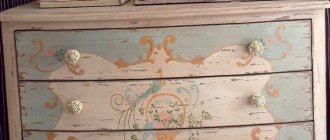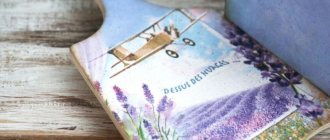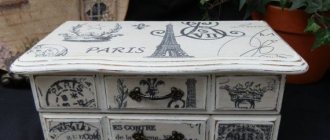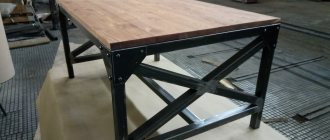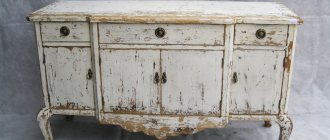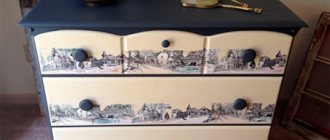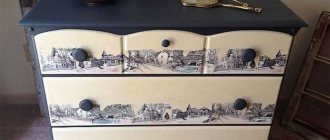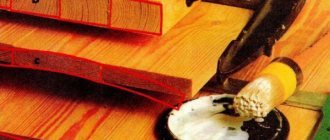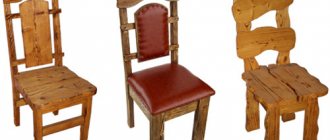Decoupage is in demand among handmade lovers. With this technique you can transform the look of old furniture and give her a second life. Using the decoupage technique, truly unique and inimitable decors are created. At the same time, there is no need to spend personal savings to turn an old chest of drawers, cabinet or table into an original antique item.
Decoupage is a decorative technique that originated in Europe several centuries ago. With its help, pictures cut out of paper or textiles are pasted onto surfaces.
Style Features
According to professional designers, one cannot help but like Provence. This direction is characterized as light and romantic. The palette is dominated by light colors, bright accents are present, but in very measured doses.
Every needlewoman who likes simple but sophisticated echoes of country can make original decor in the Provence style with her own hands.
Features of Provence style:
- Natural materials in room decoration;
- Plaster is most often chosen for wall decoration;
- All interior items have an aged appearance (naturally or artificially);
- Wooden beams are considered a mandatory component of ceiling finishing;
- Lots of light in the room;
- The interior items contain forged elements;
- An abundance of flowers: prints in finishing materials and textiles, as well as fresh flowers.
Provence is an environmentally friendly style, which is why natural materials predominate in this design. And don’t forget, this applies not only to finishing materials, but also to textiles. Provence does not tolerate synthetics in any form; taffeta and organza are alien to this style. But natural linen and cotton with unobtrusive floral motifs have become an integral part of it.
The Provencal current originates in the southeastern French province of the same name in the 15th-17th centuries.
Stones or precious woods are used as flooring. In modern Provence, you can most often find an alternative option - tiles. In addition, laminate with a wood pattern is in demand.
The abundance of sunlight contributed to the rapid fading of bright colors, which is why soft and discreet pastel shades are so popular in the Provence style.
When choosing finishing materials for walls, forget about wallpaper. Stone, wood, and, of course, plaster - this is the set necessary for Provence. An important point: the plaster is applied quite roughly, and this is also a distinctive feature of the style.
Floral patterns, among which the rose occupied a special place, gradually became a decoration not only for ceramic products, but also for other household items.
Interior doors must be white. Doors with imitation soot look very impressive. In general, patination is considered a characteristic method of finishing in this interior.
The rustic style places special demands on window openings. Ideally, they should occupy the entire wall, from floor to ceiling. Wood imitation is required. Weightless flowing curtains in light shades and with a delicate floral print are chosen as a frame for the windows.
Provincial simplicity and the absence of pompous gloss have made the French variety of country music universally in demand not only in country houses, but also in city apartments in modern metropolises.
Another important feature of French country style furnishings is the curved shapes. Tables, cabinets, chests of drawers and chairs must have smooth curves. In addition, absolutely everything is decorated in Provence: from walls and furniture to flower pots. Delicate pastels and discreet floral prints reign throughout.
The vintage appearance of the set can be emphasized with your own hands by additionally treating the surfaces.
And, of course, it is impossible to imagine Provence without wooden furniture with an aging effect. Believe me, decorating furniture in the decoupage style will make any interior cozy and enjoyable to spend time in.
Pastel colors and the dominance of light shades visually make the room even more spacious.
Concepts for decorating in the Provençal version
Don’t delay, try now to take some object inherited from your ancestors - an armchair, a table, a chair or a chest of drawers, and use several available methods yourself. If desired, decorating Provence is not so difficult. To process a product and create artificial aging, you must first prepare it; remove all removable elements, drawers and shelves.
Don’t delay, try now to take some object inherited from your ancestors - an armchair, a table, a chair or a chest of drawers, and use several available methods yourself. If desired, decorating Provence is not so difficult. To process a product and create artificial aging, you must first prepare it; remove all removable elements, drawers and shelves.
Let's look at several available techniques and concepts for aging furniture at home:
- Using paraffin and coloring materials, for this we need to have the following materials and tools on hand (pastel shades of paint, sponge, fine-grained sandpaper, wax and a chair):
- Lay paper or film on the floor to avoid contamination.
- If there is paint or varnish on the item, remove it with fine-grit sandpaper.
- then the entire surface must be thoroughly rubbed with wax parallel to the growth of the wood fibers.
- then start painting using paint in an aerosol can, as it is more convenient for painting cracks and other hard-to-reach places, hold the can at a distance of about 50-60 cm from the chair and apply the paint in a thin layer for an even coating.
- to give the effect of aging, you need to use a sponge to gradually wipe off the paint and wax, but don’t be too zealous, because in the end you can erase too much and it won’t look very nice.
- If you wish, you can apply drawings typical of Provence painting onto the resulting surface.
- To consolidate the resulting effect, cover the entire surface of the piece of furniture with 2-3 layers of varnish, you can use craquelure varnish to create as many cracks as possible.
It will be much more convenient to work with paint in a spray can.
- Steel wool of black-gray color (steel wool), it is used for grouting and polishing furniture, you can buy it in construction stores:
- Let's take an old chair again, prepare it for decoration by removing all removable elements, then use fine-grained sandpaper to remove a layer of old varnish or paint and paint it with one or more similar shades of paint.
- parallel to the growth of the fibers, let’s go through “steel wool”, using it very intensively and confidently, as a result the entire surface will be covered with a layer of black soot, take a damp cloth and wipe the piece of furniture, achieve the desired effect of antiquity, i.e. give slightly noticeable worn and dilapidated marks Provence, then go over the entire surface with a dry cloth.
- We fix the resulting surface with 2-3 layers of varnish.
Decoupage in old French design with your own hands, for this you need to have the following materials and tools (fine-grained sandpaper, acrylic white or pastel paint, napkins with images of Provence, scissors, glue, sponge, acrylic varnish, powder to create a patina effect): prepare the surface (again Let’s take a chair as an example), after removing any remaining varnish or paint from it, apply acrylic paint in 2-3 layers. cut out the selected Provençal style of design, glue it to the selected place, and carefully wipe off the remaining glue with a sponge. When the image is dry, being careful, we sand around the drawing to ensure that the paint is rubbed off. Apply acrylic varnish and then powder to create a patina effect in some places (no need to cover the entire surface). We fix the resulting Provence effect with 2-3 layers of varnish.
Well, we have learned how to do the aging of interior items in Old French design with our own hands. We hope that everything we have written here will help you create elegant and unique furniture products in the Provençal style and make your home cozy and comfortable. However, to achieve uniformity in design, use various decorative items (figurines, vases, lamps, sconces) in a rustic or nautical style.
Types of technology
Decoupage can be done in different ways and using different materials: all kinds of paints, specific varnishes, as well as napkins, textiles, wallpaper and even eggshells.
Decoupage is a surface decoration technique that imitates artistic painting.
The most popular method of decorating furniture is using crackle varnish. It is applied to the surface in a thick layer, and sometimes in several layers. And as it dries, cracks appear, reminiscent of the surface of antique interior items. Thanks to this feature, tables, cabinets and chests of drawers fit perfectly into the Provence style.
Ease of execution allows even people without artistic skills to turn any interior item into a work of art.
There are other ways to artificially age furniture:
- Mechanical impact. Using various tools, cuts, cracks and scratches are made on the surface. An important nuance: before starting work, you should make a diagram of the expected “damage”, otherwise it will be clear that the furniture is new, but damaged, and this is a completely unsuitable option for the style.
- Chemical reactions. Chemicals are applied to the surface that can “corrode” wooden furniture. Vinegar and ammonia are most often used; with their help, you can seriously change the appearance of interior items.
- Thermal impact. High temperature and sometimes open fire are used; in some cases, furniture is exposed to a special blowtorch. If you choose this method, be very careful not to harm your health or damage the furniture.
- Numerous liquid products. They are applied with brushes, rollers, sponges or spray, depending on what effect you want to achieve as a result.
For decoration, lace, paper napkins, and fabrics are used, which can be used to decorate any surface.
It is thanks to the decoupage technique that you have the opportunity to radically change the appearance of furniture, make it unique in its kind, and complement a typical piece of furniture with elegant designs and ornaments.
Modern craftsmen combine various techniques and materials in their works to decorate objects.
Before you start work, you should think in advance about what exactly and how you will use for decoration. And also prepare the surfaces in the proper way.
DIY
Decoupage of a cabinet can be done with your own hands. Not only experienced craftsmen cope well with such work, but also beginners who have never done anything like this before.
Let's look at step by step how to decorate a closet with decoupage using pictures on napkins (the most popular processing method).
- First you need to prepare all the necessary components for the planned procedures: multi-layer napkins with drawings, PVA glue, brushes, acrylic varnish, primer, sandpaper.
- Whatever cabinet you choose for modification - large or small, kitchen or in the living room - it must first be properly prepared. Be sure to carefully seal all chips and cracks with putty, if any. Wait until the materials dry.
- Next, the surface of the furniture must be sanded with sandpaper.
- It is best to treat the entire surface with a primer mixture. Due to this procedure, the walls of the structure will become as smooth and neat as possible. Drawings from napkins will be placed on such a base much easier.
- Motifs found on multi-layer napkins can be used as decorative images for this furniture. It is also acceptable to use clippings from newspapers or magazines.
- Coat the surfaces of the cabinet with PVA glue. Glue the selected drawings onto the greased base. Once all the fragments are properly glued, they will need to be left for a while and not touched. During this period the stickers will have time to dry.
- The completely dried and treated cabinet should be coated with a special acrylic varnish. The latter will need to be applied in several layers (preferably at least three). Thanks to this procedure, furniture parts and decor will be better protected from various types of damage.
- Many craftsmen, in the desire to make the surface of updated furniture more aesthetically pleasing and attractive, resort to treating the base with wax.
Cabinets restored in the shabby chic direction look very interesting and attractive.
If the front of the cabinet is made of glass, then shabby chic will be the ideal solution. If you resort to this technique, then you also need to prepare the basis for further procedures.
After this, the furniture structure can be supplemented with an old photo card or elegant patterns can be pasted that correspond to the main style of furniture that is present in the surrounding environment. It is permissible to leave pasted pictures for an indefinite period of time so that they can dry completely, and then coat them with a layer of acrylic varnish. This way you can complement cupboards or ordinary old cabinets. If you do everything correctly and carefully, you can end up with very unusual and bright furniture that will definitely not go unnoticed by your guests.
Many users are interested in what to do with a polished cabinet. Everything is simple here: first you need to sand it to erase the top shiny layer. If you leave it, the decor will stick very poorly and not so reliably. To give such furniture an antique effect, you can completely paint it brown and then treat it with a wax candle. After this, you should treat the cabinet with snow-white paint on acrylic, then once again “walk” along the base with sandpaper.
There are many ways to decorate cabinets using the decoupage technique. It is permissible to choose both flashy and expensive-looking and modest rustic options. It all depends on the environment and the style in which it is designed.
You will learn more about how to make decoupage with your own hands by watching the following video.
Process description
- We prepare the surface for work: sand and prime.
- We paint it.
- Glue the selected images.
- We fix the “applications” with varnish.
- If there is a need and desire, we use additional methods of decoration: patination of relief elements, use of two-step craquelure, spraying, etc.
- Final multi-layer varnish coating.
Before you start decorating, you need to properly prepare the selected items.
Characteristic features of furniture finishing in Provence style:
- The predominance of vegetable and floral motifs: olives, wine, and, of course, lavender.
- Bleached interior items - the image is applied exclusively to a light surface.
- Application of artificial aging technology.
- Scuffs and scrapes on surfaces.
- The predominant calm palette: olive, white, delicate shades of blue, wheat, beige, lavender and pink.
- Author's painting of furniture items.
To give a product a unique look, decoupage masters often use special techniques.
The decoration of interior items and accessories deserves special attention. Elements woven from wicker, all kinds of forged elements, as well as beautiful openwork pillowcases, woven lace and wooden figurines fit perfectly into the overall design concept.
Technology Provence
You can decorate furniture in different styles. The Provence style is considered the most gentle, romantic, cozy, and homely. Most often, kitchen furniture is decorated in this style. After all, in the kitchen, delicate little things are very important to create a cozy atmosphere.
Provence is a fairly popular technique. It is associated with the village, so it is relevant in the kitchen with the sea and the sun, with the smell of herbs, trees, and brings you closer to nature. The technique should include several necessary colors: white, cream, beige, pale yellow, pale green, pale blue, faded turquoise, faded orange, terracotta. Also, the Provence style is characterized by motifs of flowers, natural and artificial leaves.
Tools and materials
Even with certain artistic skills, it is difficult to realize decoupage ideas without the necessary tools and devices. Depending on the technology, the set of tools may vary.
Before you start decorating, you need to properly prepare the selected items.
So, what is needed to decoupage furniture in the Provence style?
- Acrylic paint. Usually white is chosen, but if desired, you can purchase any other light shade.
- High quality brush. An important condition: during the work, the lint should not fall out, otherwise you can ruin everything. When choosing a size, give preference to the average: the brush should not be too large and not too small.
- Clear varnish. This consumable will be used at the final stage; it covers the finished work.
- Bronze or gold plated paint. Choose a shade based on personal preference.
- Matte glaze. Choose one that is made from polyurethane.
- PVA glue. To work, it must be diluted with water.
- Various stencils. This is not necessary, but it is better to have them at hand, then you can easily make the missing image yourself to make the picture complete.
- Sandpaper of different grits.
Prepare the necessary materials: acrylic paints, glue, decoupage varnish, brushes, napkins.
Decoupage kitchen
Decoupage in the kitchen will update the decor, add cleanliness, freshness, and newness. Women spend a lot of time in the kitchen. The interior can become boring, but thanks to this technology you can add at least something new to the boring interior. Provence style would be an excellent choice.
If it is impossible to purchase new furniture, kitchen decoupage will help to temporarily refresh the interior and old furniture. In the kitchen, furniture wears out and gets damaged faster than in other rooms. Therefore, some defects can be covered with a beautiful pattern suitable for the kitchen.
Kitchen decoupage will help the creative housewife realize her most fantastic dreams and desires for decorating kitchen furniture.
Step-by-step instruction
Let's consider the procedure for decoupaging a cabinet in Provence style.
First of all, think about the pattern that will be applied to the surface. In accordance with the invented design, a stencil is made from low-density paper. After this, acrylic paint is applied to the prepared surface (cleaned of dirt and dust, and thoroughly cleaned). It should be applied in two layers.
The surface is covered with a primer; after it has dried, you can proceed to painting the main background.
After this, the prepared images are applied to the places previously determined for them, and a layer of glue is applied over the images. It is better to do this procedure using a small brush - it will be more accurate, and you will definitely not miss the attached pictures. The glue must dry completely, so the surface is left for at least one hour.
The pattern is straightened with a brush, being careful not to damage it, then it is glued with another layer of glue, applying it on top of the pattern.
Then a clear varnish is applied and left for several hours until completely dry. After the clear varnish has dried, another layer of varnish is applied, but this time it is water-based. With the help of a regular hairdryer and water-based varnish, it is possible to create an amazingly beautiful effect of blurred paint.
After the process, it is recommended to leave the furniture for at least three hours.
A layer of bronze or gold paint is applied along the contour of the resulting pattern. This seemingly unnoticeable little step will give your closet an antique charm and make it look luxurious.
A prerequisite: after each of the steps described above, it is important to let the cabinet (table or chest of drawers) dry thoroughly, then there will be no problems with the subsequent stages of work.
The above method of creating decoupage is considered the easiest to implement. Even a person who does not have the slightest artistic skills can create a masterpiece in this way. Fortunately, today you can purchase all the necessary materials to create unique images on pieces of furniture.
Decoupage furniture in the Provence style allows you to create a corner of southern France in your room.
Another interesting technique for applying images is called spattering. Thanks to it, you get interior elements that are ideal for the Provence style. The process is also considered easy to perform. You will need dark paint and a stiff bristled brush. After the image is applied to the surface of the cabinet, table or chest of drawers and covered with a top layer of varnish, a brush, previously dipped in paint, is brought to it and a gloved hand is passed over the bristles.
Important: the direction of movement is towards you. Thus, a unique dot pattern remains on the surface.
After the varnish has dried, the furniture can be used for your pleasure.
Decoupage technology involves performing a series of actions on furniture, after which the interior items get an aged look. This process is completely simple, and even a beginner can cope with it. It is this finishing that allows you to end up with a unique, almost antique item that fits perfectly into the Provence style.
Advice from skilled craftswomen
- When decoupaging a kitchen table with your own hands for a kitchen in ethno, country or Provence style, it is recommended to select appropriate designs: wildflowers, butterflies, cats, dogs, vegetables, fruits, intricate patterns, compositions with rustic motifs.
Decoupage wall cabinets in country style
Kitchen table with butterflies
Dining area decorated with vegetable designs
- For a kitchen in a classic style, designs with luxurious paintings, bouquets of garden flowers, vines, and angels are more suitable. In addition to decoupage, you can use brushing, gilding, crackle and shabby techniques here.
Stunning stools after decoupage for a classic interior
The kitchen cabinet doors are decorated with images of angels.
You can also decoupage kitchen cabinets or a set in general in this way: cover the furniture with paper soaked in coffee. To do this, sprinkle sheets of paper with water, sprinkle instant coffee on them, rub lightly and let the paper dry. Voila! The result was very original and “tasty” furniture.
Applying instant coffee
- As for decoupage in the design of a modern kitchen, newspapers, various inscriptions, bright magazine clippings, black and white photos depicting stylish objects or cities, geometric shapes, zebra and leopard colors will harmoniously fit here.
Modern decoupage
Fashionable decoupage set
Dining table decorated with magazine cutouts
